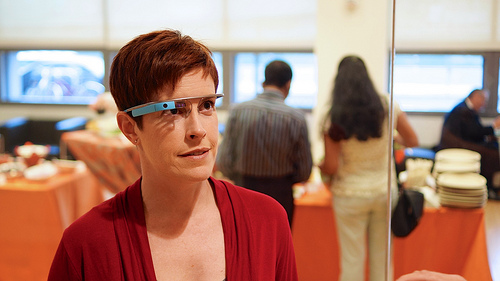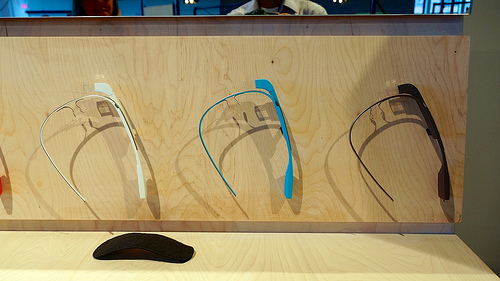Woman with Google Glass on ticketed for distracted driving
Google Glass, a wearable computer that the user dons as a pair of glasses, is as useful as a smartphone and as easy to use as, well, a pair of glasses. The device translates your own voice; sends messages; and pulls up directions “right in front of you,” as Google says, among other functions, helping drivers and non-drivers alike out of jams. But Google Glass’ high-tech innovation couldn’t get one California woman out of a ticket for driving while wearing the device.

Google Glass could make a great driving aid… if it weren’t such a distraction. From tedeytan.
The driver, Cecilia Abadie, posted her ticket on her Google+ page, and claims that she wasn’t using Google Glass when she was ticketed this past October in San Diego – just wearing it. The ticket reads, “Driving with monitor visible to driver (Google Glass).” Abadie’s caption laments, “Is #GoogleGlass illegal while driving or is this cop wrong??? [sic] Any legal advice is appreciated!!” Abadie was also written up for driving 80 mph in a 65 mph area.
Abadie is considering fighting the ticket, according to local news site WPTV. “The law is not clear, the laws are very outdated,” Abadie told WPTV. She suggested that navigating the roads with Google Glass might be safer than with smartphone or other GPS device. “Maybe Glass is more a solution to the cellphone problem than a problem.” However, California has clear laws on the books against texting while driving and other forms of distracted driving, including 2009 laws which “makes it an infraction to write, send, or read text-based communication on an electronic wireless communications device, such as a cell phone, while driving a motor vehicle.”
Laws against using monitor use are also clear, according to the state’s department of motor vehicles, which specifically states: “A person shall not drive a motor vehicle if a television receiver, a video monitor, or a television or video screen, or any other similar means of visually displaying a television broadcast or video signal that produces entertainment or business applications, is operating and is located in the motor vehicle at a point forward of the back of the driver’s seat or is operating and the monitor, screen, or display is visible to the driver while driving the motor vehicle.”
Distracted driving is a major, and often fatal problem, with 80% of crashes and 65% of near-crashes involving a form of distraction, according to NHTSA and the California DMV. California Highway Patrol officer Marc Hale commented on the Google Glass ticketing case, telling local news WPTV that drivers should not be using the device while driving: “Anything that takes your attention away from the motoring public in front of you is a distraction.”

Glass is set to go on sale this winter, but most states have yet to legislate to account for their impact on drivers’ attention. From tedeytan.
Glass is not yet widely available, though Google has distributed approximately 10,000 of the devices to early adopters like Abadie, a software developer. The product arguably crosses traditional boundaries — is it a computer, a smartphone, a television, or a hybrid of all three? — and Abadie’s case may result in changing the law to include new devices. Although this is likely the first reported ticket for a driver using Google Glass, reports from Delaware, New Jersey, West Virginia, Arizona, and the UK reveal that the product may be regulated or eventually even banned for use by drivers on the road.
Category: Traffic law

















